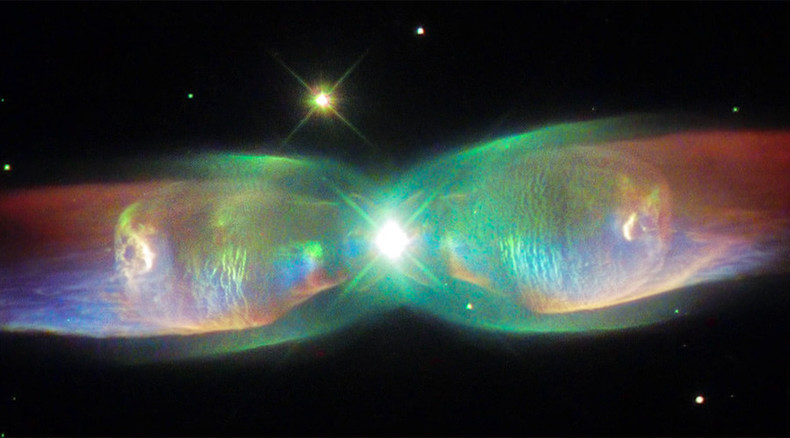:format(jpeg):mode_rgb():quality(90)/discogs-images/R-4003896-1352013925-4683.jpeg.jpg)
_____________________________
The "Beau Brummelstones!"

Posted on 11/24/2018 6:35:38 AM PST by ETL
Phobos’ grooves, which are visible across most of the moon’s surface, were first glimpsed in the 1970s by NASA’s Mariner and Viking missions.
Over the years, there has been no shortage of explanations put forward for how they formed.
Some planetary researchers have posited that large impacts on Mars have showered the nearby moon with groove-carving debris. Others think that Mars’ gravity is slowly tearing Phobos apart, and the grooves are signs of structural failure.
Still other scientists have made the case that there’s a connection between the grooves and the impact that created a large crater called Stickney.
In the 1970s, University of Lancaster’s Professor Lionel Wilson and Brown University’ Professor Jim Head proposed the idea that ejecta — bouncing, sliding and rolling boulders — from Stickney may have carved the grooves.
For a moon the size of the diminutive Phobos (17 miles, or 27 km, across), Stickney is a huge crater at 5.6 miles (9 km) across.
“The impact that formed it would have blown free tons of giant rocks, making the rolling boulder idea entirely plausible,” said Ken Ramsley, a researcher in the Department of Earth, Environmental and Planetary Sciences and the School of Engineering at Brown University.
“But there are also some problems with the idea. For example, not all of the grooves are aligned radially from Stickney as one might intuitively expect if Stickney ejecta did the carving And some grooves are superposed on top of each other, which suggests some must have already been there when superposed ones were created.”
“How could there be grooves created at two different times from one single event?”
(Excerpt) Read more at sci-news.com ...
Beau Brummelstones (Flintstones)
https://www.youtube.com/watch?v=aIo-hIYPklU
This moon has so little gravity that the boulders that supposedly made the groves would have had to be enormously heavy to not bounce off the surface
If you want to watch some absolutely astounding videos on the cosmos, check out the videos from Spike Psarris. Chocked full of amazing facts about the Universe. https://www.creationastronomy.com
For example, I did not realize that not only are there millions of galaxies, but that each one of them has hundreds of billions of stars! So when God compared the number stars with the sands of the seashores, a fact that mankind could not have known for thousands of years, He was telling the absolute truth. And of course, mankind could only see as many stars as were visible with the naked eye, until relatively recently.
There are believed to be well over one hundred billion other galaxies.

If you want on or off the Electric Universe Ping List, Freepmail me.
Utterly preposterous!
You must bear in mind that these celestial bodies are extremely fragile, low-density conglomerations of loosely-packed boulders and dust (possibly also ice), with a covering of regolith, held together by extremely weak gravitational forces. Think "7-layered wedding cake" or slightly denser "dust-bunny."
They are simply too fragile to have survived such a hypothetical cosmic collision intact.
Regards,
Incredible, isn’t it?
Beyond incredible.

It features Stickney crater, but the overlapping grooves are clearly visible...
To my weird, pattern-seeking eye, many appear to originate at recent, small craters...
TXnMA

We have so far visited or flown by more than a dozen comets and landed on at least one and found zero indications of ice. They have been bone dry, indistinguishable from the asteroids we’ve flown by and/or visited. The primary differences have been the comets have a far different electrical charge than the asteroids. . .
No one is claiming "plasma burns" or that they are "made of plasma." They create a plasma which enters a glow discharge state. When the electron start leaving the mass of the comet the strip material from that mass. This has been observed occurring in plasma laboratories and can be scaled infinitely as voltage and amperage increases. The surfaces of the comets we’ve visited show signs of such electron plasma sculpting. H2O seen in the spectra of the comae of comets is created by the interaction of ionic OH Hydroxyl radicals machined off the dry rocks by the charge plasma encountering the free Hydrogen ions in the Solar winds which create the Cometary tail and combine chemically to make new Water.
Dr. Jessica M Sunshine, director of the Spectographic team on the Deep Impact project in which a 670 pound space craft was collided with Comet Wild 2 was shocked at the purity of the water they were getting in a colimated spew from the impact point, just in a cone 3° off vertical from the perpendicular of the angle of the incoming projectile.
"It was as if we were seeing the water being created before our eyes," said Dr. Sunshine, although she would later buy into the orthodox theory that deep impact had punched through a surface crust into a deep cavern of pure H2O, water which orthodox theory claims must be converted to steam only by solar heating which must somehow raise the surrounding rock to above water’s boiling point, which then converts the water to high-pressure steam, which then finds its way through the rock to vent out to space to form the huge comae and tails of comets. . . all in volumes of space where the sun cannot bring shaded temperatures above 150° BELOW the freezing point of water, much less the ability to raise hundreds of millions of tons of rock, which everything below the cometary surface is by definition is SHADED (I.E. not in direct sunlight) to the vaporization point of that water! That has NEVER been demonstrated.
When the Deep Impact space craft hit Wild 2, the Electrical/Plasma Universe cosmologists made nineteen specific predictions of what would be observed which were counter to what orthodox cosmologists claimed would be observed. While the orthodox cosmologists were "surprised, stunned, and shocked" at what they observed, especially at finding less than 1/100th the amount of water they were expecting and the rocky surface, all nineteen of the predictions made by the Electric/Plasma Universe cosmologists were observed and fully confirmed their expectations.
If the test of any hypothesis or theory is how well it can predict future observations or the results of tests, or of those predictions to not be falsified, then the Electric/Plasma driven Universe Hypothesis is looking much better in this case than the gravity driven universe hypothesis whose adherents keep being "surprised, stunned, and shocked" by what Electric/Plasma Universe adherents have predicted will be observed and can explain why without invoking magical unseen, unfindable "dark matter" or "dark energy" to have their universe work.





On a visit to the NASA Jet Propulsion Laboratory in 2005, Jackson Lee made embarrassing news by asking if the Mars Pathfinder had taken an image of the flag planted there in 1969 by Neil Armstrong.[2]
Prior to the 110th Congress, Jackson Lee served on the House Science Committee and on the Subcommittee that oversees space policy and NASA.
http://web.archive.org/web/20100409095818/http://en.wikipedia.org/wiki/Sheila_Jackson_Lee
Why do all the other planets with ‘moons’ have NAMES? Our moon doesn’t have a name - just boring old, ‘Moon.’
I mean they’re ALL considered ‘moons,’ correct? A ‘moon’ is an object in space, like a ‘star’ or a ‘comet.’
We need a pretty name for OUR Moon! :)
"The Moon" is the name. Like "The Bronx". Or "The Robot" on Lost In Space. :)
To further show the absurdity of the boulder theory, the average striation on Phobos is about 98 feet deep. If we were to assume our hypothetical boulder could gouge out a rut ~10% of its diameter, then the average boulder rolling on Phobos would have been almost 1,000 feet in diameter. . . and round to roll. Yet, gravity driven universe cosmologists have told us that the 27 mile x 22 mile x 18 mile potato shaped moon Phobos is too small with too weak of a gravity field to have formed a round shape, yet somehow, literally dozens if not hundreds of nearly perfectly round boulders averaging 1,000 feet in diameter are claimed to have miraculously rolled straight around the surface of Phobos all in the same direction, ignoring surface features, variations in elevation, and craters, all following the planetoid‘s curvature despite a gravity field where a on Earth ten ton (20,000 pounds) boulder, would weigh a mere 114 pounds on Phobos. . . although it would retain the same inertia (resistance to begin being moved or stop moving) as it would have on Earth.
I again repeat the most serious question this theory leaves unanswered. . . The lack of the boulders themselves. Should there not be a seriously large boulder at the end of every track or do they hypothesize the boulders, on finishing their racetracks, all announced they were going to some cosmic Disneyland? If not, where are the boulders?
This one’s so easy a caveman could see it.
That big scoop on the end there? That’s where the engine housing went.
The streaks are from the engine exhaust as the thing was braking to enter it’s new orbit!
I mean, come on! It’s obvious.
Well, I don’t like it! She deserves a more beautiful name (Said the Moon Goddess, Diana, LOL!) I’m starting a petition. ;)
Well, we’re big rock singers
We got golden fingers
And we’re loved everywhere we go...(That sounds like us)
We sing about beauty and we sing about truth
At ten thousand dollars a show...(Right)
We take all kinds of pills that give us all kind of thrills
But the thrill we’ve never known
Is the thrill that’ll getcha when you get your picture
On the cover of the Rollin’ Stone
Dr. Hook
You’ve got the answer! I saw it on Star Trek, the front end was eating everything in it’s path! Giant cosmic Tremors monster!
Thanks TXnMA and Swordmaker.
|
Disclaimer: Opinions posted on Free Republic are those of the individual posters and do not necessarily represent the opinion of Free Republic or its management. All materials posted herein are protected by copyright law and the exemption for fair use of copyrighted works.